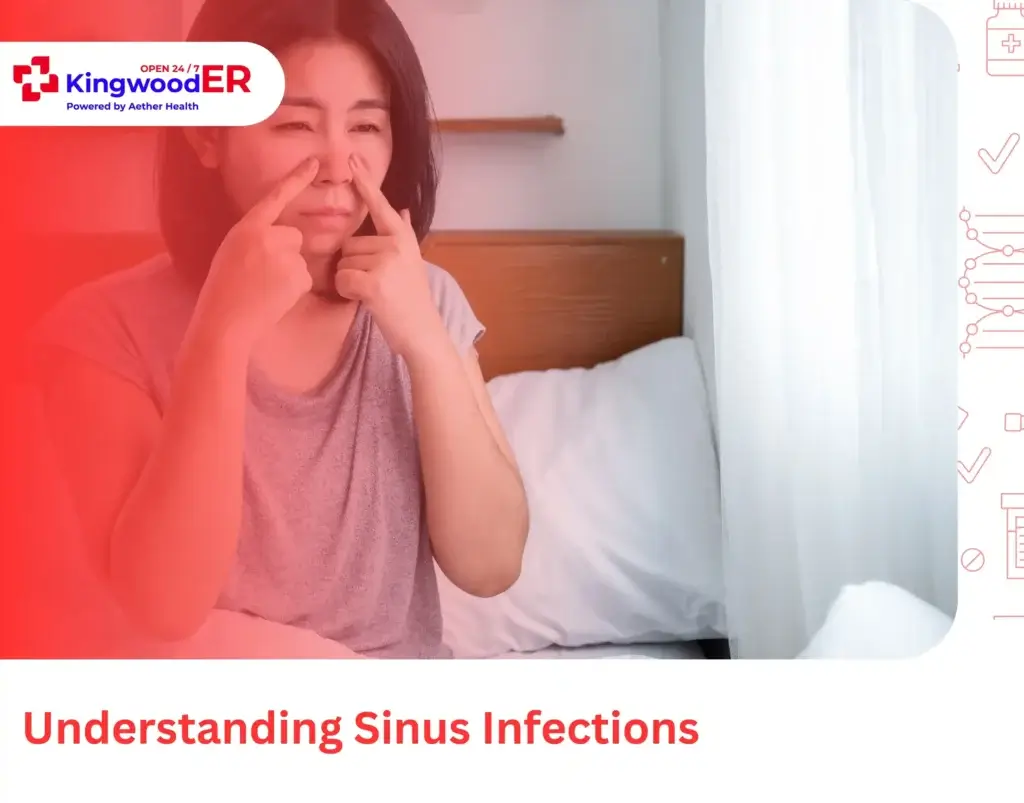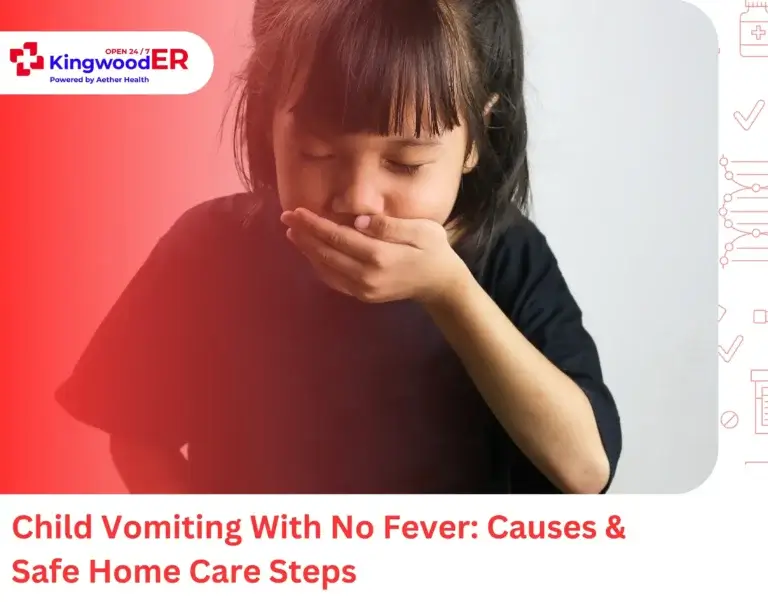Most sinus infections resolve with rest and over-the-counter treatments, but some take a dangerous turn. Can sinus infection turn into pneumonia? Unfortunately, yes and this progression affects thousands annually.
When sinus drainage flows into your lungs or weakened immunity allows bacteria to spread, a simple sinus infection can become life-threatening pneumonia.
Let’s understand the early warning signs and prevention strategies to avoid this potentially serious complication that sends thousands to emergency rooms annually.
Understanding Sinus Infections

A sinus infection (sinusitis) develops when the tissue lining your sinus cavities becomes inflamed. This typically happens due to viral or bacterial pathogens. The inflammation triggers a range of uncomfortable symptoms, including:
- Nasal congestion
- Difficulty breathing through the nose
- Pressure or pain around the face, especially in the forehead, cheeks, and eye
- Thick mucus discharge from the nose or postnasal drip
- Persistent fatigue and a general feeling of being unwell
- Possible fever and headache
- A profound sense of being drained or depleted of energy
As your system works overtime to fight off the infection, resources are diverted from your daily functioning. That’s why you feel sluggish and mentally foggy with sinus infection. The constant facial pressure, impaired breathing, and disrupted sleep caused by congestion all contribute to this overwhelming fatigue. Even routine tasks can feel exhausting.
Sinus Infection, Bronchitis, and Pneumonia: A Common Progression
Respiratory infections often follow a predictable downward spiral:
Sinus Infection → Bronchitis → Pneumonia
This progression starts with a sinus infection, where viral or bacterial pathogens inflame the sinus cavities. Infected mucus then drains down your throat into the bronchi, which the airways leading to your lungs. This drainage irritates and inflames the bronchial tubes, creating bronchitis.
Without proper treatment, bronchitis weakens your lung defenses. Bacteria can then penetrate deeper into lung tissue and cause pneumonia. Each stage makes your respiratory system more vulnerable to the next level of infection. Breaking this cycle early prevents serious complications and hospitalizations.
Read More: Can A Sinus Infection Turn into Bronchitis and How to Prevent it?
Understanding Pneumonia
Pneumonia is a serious lung infection that causes inflammation in the air sacs (alveoli) of one or both lungs. These tiny sacs can become filled with fluid or pus, and interfere with normal breathing and oxygen exchange. Pneumonia can be triggered by various infectious agents, including:
- Bacteria, such as Streptococcus pneumoniae
- Viruses, like influenza, RSV (respiratory syncytial virus), or even the common cold
- Fungi, which typically affect individuals with weakened immune systems
Common symptoms of pneumonia include:
- Persistent or worsening cough
- Chest pain
- Shortness of breath
- Fever, chills, and sweating
- General fatigue or malaise
While some cases of pneumonia are mild and manageable at home, others can be life-threatening. Risk factors increase particularly for older adults, young children, and people with underlying health conditions like asthma, diabetes, or weakened immune systems.
How Can a Sinus Infection Turn into Pneumonia?

Sinus infections and pneumonia affect different parts of the respiratory system. Sinusitis occurs in the nasal cavities and pneumonia in the lungs, but they are linked more closely than many realize. This is especially true when the same pathogens or underlying conditions are involved.
Here’s how a sinus infection can potentially set the stage for pneumonia:
1. Weakened Immune Defenses
Chronic or severe sinus infections can tax the immune system over time. When your body is busy fighting off one infection, it may become more vulnerable to additional threats. This lowered immunity creates an opportunity for viruses or bacteria to invade deeper parts of the respiratory tract, including the lungs.
2. Postnasal Drip and Lower Airway Exposure
Mucus from inflamed sinuses can drip down the back of the throat, a symptom known as postnasal drip. In some cases, this mucus can carry infectious agents into the lower respiratory tract. If the lungs become irritated or overwhelmed by this constant exposure, inflammation or infection may develop.
3. Co-Infections
It’s possible for the same virus or bacteria to cause both a sinus infection and pneumonia. In such cases, the illnesses may occur simultaneously or one may follow the other. For example, influenza can initially present as a sinus infection but later progress into a more serious lung infection.
4. Aspiration Risk
In certain individuals particularly those who are bedridden, elderly, or have swallowing difficulties post nasal drip can pose an aspiration risk. If bacteria-laden secretions are accidentally inhaled into the lungs, they can cause aspiration pneumonia.
Who Is Most at Risk?
Certain groups are more vulnerable to complications from a sinus infection, including:
- Older adults
- Children under 5
- People with asthma or COPD
- Smokers
- Individuals with weakened immune systems
- Those with chronic sinusitis or frequent upper respiratory infections
These risk factors either weaken your immune response or create conditions where bacteria spread more easily from your sinuses to your lungs. If you’re in any high-risk category, early treatment becomes crucial. Waiting for symptoms to resolve on their own increases your pneumonia risk significantly.
How to Stop Your Sinus Infection from Turning into Pneumonia

Most pneumonia cases that start from sinus infections are preventable. The key lies in breaking the infection cycle early; before bacteria establish a foothold in your lower respiratory tract. These six strategies target the specific pathways that allow sinus infections to progress:
Treat Sinus Infections Promptly
Don’t wait for symptoms to worsen. Early intervention with rest, hydration, warm compresses, and saline rinses helps your body eliminate infection before it spreads. Bacterial sinusitis may require antibiotics within the first week to prevent complications.
Clear Nasal Congestion Effectively
Blocked sinuses create breeding grounds for bacteria. Saline sprays, decongestants, and neti pots reduce pressure and prevent dangerous mucus buildup. The goal is maintaining drainage, because stagnant mucus can become infected mucus.
Also Read: Is Nasal Spray Effective for Sinus Infections?
Avoid Smoking
Smoking damages the cilia (tiny hair-like structures in your airways) that help clear out mucus and pathogens. It also thickens mucus and weakens your immune system, all of which increase the risk of lung infections like pneumonia.
Support Your Immune System Daily
A strong immune system is your best line of defense. Eat a nutrient-rich diet, stay active, manage stress, and get sufficient sleep to keep your body resilient against infections.
Stay Up to Date on Vaccinations
Vaccines for flu, COVID-19, and pneumococcal pneumonia offer a crucial defense against serious respiratory complications.
Practice Good Hygiene
Wash hands regularly, avoid touching your face, and avoid close contact with sick individuals to reduce the spread of respiratory pathogens.
Diagnosing Sinusitis and Pneumonia
Sinus Infection Diagnosis
A physician will evaluate your symptoms and may perform:
- Physical examination
- Nasal endoscopy
- Sinus CT scan for chronic cases
- Nasal cultures (in rare cases)
Pneumonia Diagnosis
When pneumonia is suspected, the physician may order:
- Chest X-ray
- Blood tests to check for infection
- Pulse oximetry to measure oxygen levels
- Sputum culture to identify the pathogen
If you’re unsure whether your congestion is from a sinus infection or something else, consult a medical professional. In many cases, symptoms like facial pressure, thick nasal discharge, and fever point to sinusitis, while sneezing, itchy eyes, and clear mucus are more typical of allergies. Recognizing these patterns can help you manage your symptoms more effectively.
When to Seek Emergency Care
If you experience any of the following, seek immediate medical help:
- Trouble breathing
- Chest pain
- Sudden high fever with chills
- Confusion or difficulty staying awake
- Cyanosis (bluish lips or fingertips)
These signs suggest pneumonia or other serious complications may have developed.
While a sinus infection doesn’t directly lead to pneumonia, it can create conditions that make your lungs more susceptible, especially if you have a weakened immune system, chronic sinus issues, or existing respiratory conditions. In some cases, sinus pressure may even affect nearby structures like the ears, leading to discomfort or a sinus-related ear infection.
At Kingwood Emergency Room, our experienced team of physicians, nurses, and support staff is committed to prevent these complications from escalating. We prioritize your comfort and well-being, ensuring you receive the time, attention, and high-quality treatment you deserve.
FAQs
1. Can pneumonia heal on its own?
Mild viral pneumonia may improve without antibiotics, especially in healthy individuals. However, bacterial pneumonia often needs medical treatment to prevent complications.
2. Is steam good for pneumonia?
Steam can help ease congestion and breathing discomfort, but it does not treat the infection itself. It should be used as a supportive measure, not a cure.
3. What symptoms suggest a sinus infection is getting worse?
Fever, chest pain, persistent cough, or difficulty breathing may indicate it’s spreading and could develop into pneumonia.
4. Should I go to the ER if I suspect pneumonia?
Yes, especially if you experience shortness of breath, high fever, confusion, or chest pain it could be a medical emergency.
5. Can antibiotics for a sinus infection prevent pneumonia?
Antibiotics may help if the cause is bacterial, but they won’t work for viral infections. Always consult your doctor before using antibiotics
6. Can children get pneumonia from a sinus infection?
Yes, especially if they have other health issues or if the sinus infection is prolonged or not treated properly.




